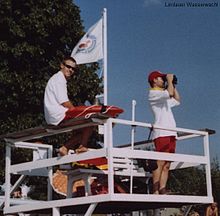Draft:Clothed swimming
 | Draft article not currently submitted for review.
This is a draft Articles for creation (AfC) submission. It is not currently pending review. While there are no deadlines, abandoned drafts may be deleted after six months. To edit the draft click on the "Edit" tab at the top of the window. To be accepted, a draft should:
It is strongly discouraged to write about yourself, your business or employer. If you do so, you must declare it. Where to get help
How to improve a draft
You can also browse Wikipedia:Featured articles and Wikipedia:Good articles to find examples of Wikipedia's best writing on topics similar to your proposed article. Improving your odds of a speedy review To improve your odds of a faster review, tag your draft with relevant WikiProject tags using the button below. This will let reviewers know a new draft has been submitted in their area of interest. For instance, if you wrote about a female astronomer, you would want to add the Biography, Astronomy, and Women scientists tags. Editor resources
Last edited by Auric (talk | contribs) 18 days ago. (Update) |

- Clothed swimming** consists of swimming without "Western" swimwear (bikinis, swim shorts...) but with everyday clothes, those that are not usually designed for swimming: T-shirts, pants... [citation needed]
Swimming in "non-revealing" clothing (i.e., clothes that show "little" skin), whether usual or special (stinger suit, wetsuit...), is a common practice in many countries around the world, a cultural practice with multiple reasons: modesty, religion, health, survival... In Asian or Muslim cultures, swimming partially clothed is a norm.
Cultural Aspects[edit]
Asia[edit]
Swimming clothed is a common practice in many Asian countries[1]: Vietnam[2], Thailand[3], India[4], Bangladesh[5][6]... The reasons are manifold:
- Modesty,
- Humility (lack of means to buy specific swimwear and humility not to expose one's body),
- Asian culture appreciating pale skin (aesthetic criterion),
- Protection against ultraviolet (UV) rays.
In Indian cinema, scenes of "wet sarees" (at the beach, for example) suggest nudity by implying it, as it is taboo.
-
Bathing in a waterfall in Malaysia.
-
Three Burmese women in a waterfall in Pyin Oo Lwin in 2012.
-
In a Thai waterfall, in the shade.
-
Beach in Sri Lanka.
Arab-Muslim World[edit]
Some women of Muslim religion swim clothed, in veils or niqabs, for example in Morocco[7][8].
The reasons are similar to those of Asian peoples: religion, sun protection, humility...
Western World[edit]
In Western culture, swimming is generally done in swimsuits as revealing as underwear.
However, Australians and New Zealanders often add UV tops to protect themselves from ultraviolet (UV) rays.
Health Benefits[edit]
Protection against the sun[edit]
Clothes create shade and therefore help to prevent sunburns, which is why:
- Many parents automatically put a T-shirt on their child at the beach,
- Lifeguards outdoors wear T-shirts despite the heat,
- Populations of South Asia (close to the equator) swim clothed[1] (among other reasons).

However, regular clothes do not block all ultraviolet rays, as they are often made of natural fiber such as cotton, which blocks UV rays less effectively than synthetic fibers (Lycra, spandex...)[9]. That is why surfers sometimes wear synthetic T-shirts called UV tops, rash vests, or "rashguards"; some models have long sleeves and/or a high collar to protect the forearms, neck, and nape. This type of clothing can of course be used for other water activities, starting with simple leisure swimming[10].
References[edit]
- ^ a b "Swimming in Clothes? Just do it!". wackywet_help. Retrieved December 31, 2014.
- ^ Kevin Bodin (11 February 2013). "Plages au Vietnam : quelques petites choses à savoir". voyageurs-du-net.com (in French). voyageurs_du_net. Retrieved April 7, 2013.
- ^ "Savoir vivre et coutumes locales en Thaïlande". thailande-tourisme.com (in French). Thaïlande Tourisme - Guide et portail sur la Thaïlande. 16 Dec 2010. thailande_tourisme. Retrieved April 7, 2013.
- ^ "Inde". tripteaser.fr (in French). April 7, 2013. trip_teaser. Retrieved February 12, 2024.
- ^ "Vacances bangladaises à Kuakata". la-croix.com (access to the full article requires payment) (in French). 20 December 2012. la_croix_bangladesh. Retrieved April 7, 2013.
- ^ Alexandre Marchand (22 Feb 2010). "Cox's Bazar : le Bangladesh va à la plage, sans bikini ni crème solaire". blogs.rue89.com (in French). Rue89, nouvelobs.com. rue89_coxs_bazar. Retrieved April 7, 2013.
- ^ Arthur Chappell (April 6, 2013). "In Defense of the Wetlook Fetish". arhurchappel.me.uk. arthur_in_defense. Retrieved February 12, 2024.
- ^ Sarah Blanquet (8 Oct 2008). "Demoiselles de nage". the blog photos.blogs.liberation.fr (via an album of photos taken in this location) (in French). Libération. demoiselles_de_nage. Retrieved April 6, 2013.
- ^ Swiss Cancer League. "Textiles de protection solaire" (in French). ligue_cancer_suisse. Retrieved April 4, 2013.
- ^ "Les tops UV aident à réduire le risque de cancer de la peau chez les enfants". mygc.com.au. 20 February 2012. etude_australienne_via_presse. Retrieved April 4, 2013.




